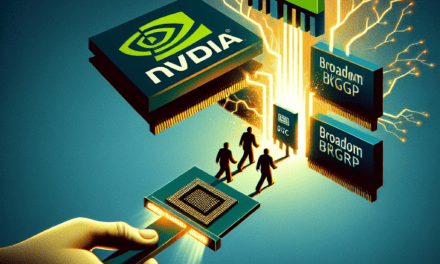“Charting the Future: Nvidia’s Path to Innovation and Growth in 3 Years”
Introduction
Nvidia Corporation, a leading player in the semiconductor industry, has consistently captured the attention of investors and analysts alike with its innovative technologies and robust market presence. As a pioneer in graphics processing units (GPUs) and a key contributor to advancements in artificial intelligence (AI), gaming, and data centers, Nvidia’s stock performance is closely watched as a barometer of tech sector health and future potential. With the rapid evolution of AI applications, the growing demand for high-performance computing, and Nvidia’s strategic expansions and partnerships, the question of where Nvidia’s stock will be in three years is a topic of significant interest. Investors are keen to understand how Nvidia’s strategic initiatives, market trends, and competitive landscape will shape its financial trajectory and stock valuation in the coming years.
Analyzing Nvidia’s Market Position and Future Growth Potential
Nvidia Corporation, a leading player in the semiconductor industry, has consistently demonstrated its prowess in graphics processing units (GPUs) and artificial intelligence (AI) technologies. As investors and analysts look to the future, the question of where Nvidia’s stock will be in three years becomes increasingly pertinent. To understand Nvidia’s market position and future growth potential, it is essential to examine the company’s current standing, its strategic initiatives, and the broader industry trends that could influence its trajectory.
Currently, Nvidia holds a dominant position in the GPU market, which is a critical component for gaming, data centers, and AI applications. The company’s GPUs are renowned for their high performance and efficiency, making them the preferred choice for both consumers and enterprises. This strong market position has been bolstered by Nvidia’s continuous innovation and its ability to anticipate and adapt to technological advancements. For instance, the introduction of the Ampere architecture has significantly enhanced the performance of its GPUs, thereby solidifying its leadership in the industry.
In addition to its core GPU business, Nvidia has been strategically expanding its footprint in the AI and data center markets. The acquisition of Mellanox Technologies in 2020 was a pivotal move that strengthened Nvidia’s data center capabilities, allowing it to offer comprehensive solutions that integrate networking, computing, and storage. This expansion is crucial as the demand for AI-driven solutions and cloud computing continues to surge. Nvidia’s AI platforms are increasingly being adopted across various sectors, including healthcare, automotive, and finance, which underscores the company’s potential for sustained growth.
Moreover, Nvidia’s foray into the automotive industry with its autonomous vehicle technology presents another avenue for growth. The company’s DRIVE platform is designed to support the development of self-driving cars, a market that is expected to expand significantly in the coming years. As automotive manufacturers and tech companies invest heavily in autonomous driving technologies, Nvidia’s expertise and early entry into this space position it well to capitalize on this burgeoning market.
However, it is important to consider the challenges that Nvidia may face in the coming years. The semiconductor industry is highly competitive, with companies like AMD and Intel constantly vying for market share. Additionally, geopolitical tensions and supply chain disruptions could pose risks to Nvidia’s operations and growth prospects. Despite these challenges, Nvidia’s robust financial health, characterized by strong revenue growth and a solid balance sheet, provides a buffer against potential headwinds.
Looking ahead, Nvidia’s stock performance over the next three years will likely be influenced by its ability to maintain its leadership in the GPU market, successfully expand its AI and data center businesses, and capitalize on emerging opportunities in the automotive sector. Furthermore, the company’s commitment to research and development will be crucial in sustaining its competitive edge and driving innovation.
In conclusion, while predicting the exact trajectory of Nvidia’s stock is inherently uncertain, the company’s strong market position, strategic initiatives, and alignment with key industry trends suggest a favorable outlook. As Nvidia continues to navigate the evolving technological landscape, its potential for growth remains significant, making it a compelling consideration for investors with a long-term perspective.
Key Factors Influencing Nvidia’s Stock Performance
Nvidia Corporation, a leading player in the semiconductor industry, has consistently captured the attention of investors and analysts alike. As we look ahead to the next three years, several key factors are poised to influence Nvidia’s stock performance. Understanding these elements is crucial for investors seeking to make informed decisions about their portfolios.
First and foremost, the demand for Nvidia’s products in the gaming sector remains a significant driver of its stock performance. Nvidia’s graphics processing units (GPUs) are renowned for their superior performance, making them a preferred choice among gamers worldwide. As the gaming industry continues to expand, driven by advancements in virtual reality and the increasing popularity of e-sports, Nvidia is well-positioned to capitalize on this growth. Consequently, the sustained demand for high-performance GPUs is likely to bolster Nvidia’s revenue and, by extension, its stock price.
In addition to gaming, Nvidia’s foray into artificial intelligence (AI) and machine learning represents another critical factor influencing its stock trajectory. The company’s GPUs are not only pivotal in gaming but also serve as the backbone for AI applications. As industries across the board increasingly adopt AI technologies to enhance efficiency and innovation, Nvidia’s role as a key supplier of AI hardware is expected to grow. This expansion into AI markets could significantly boost Nvidia’s financial performance, thereby positively impacting its stock valuation.
Moreover, Nvidia’s strategic acquisitions and partnerships play a vital role in shaping its future stock performance. The company’s acquisition of Arm Holdings, a leading semiconductor and software design company, is a prime example. This acquisition, if successfully completed, could provide Nvidia with a competitive edge by expanding its reach into new markets and enhancing its technological capabilities. Such strategic moves are likely to strengthen Nvidia’s market position, potentially leading to an appreciation in its stock value over the coming years.
Furthermore, the global semiconductor shortage presents both challenges and opportunities for Nvidia. While supply chain disruptions have affected production and delivery timelines, Nvidia’s strong market position and robust demand for its products may allow it to navigate these challenges more effectively than some competitors. If Nvidia can successfully manage these supply chain issues, it could emerge stronger, with an enhanced reputation and increased market share, which would likely reflect positively on its stock performance.
Additionally, Nvidia’s commitment to innovation and research and development (R&D) is a crucial factor that cannot be overlooked. The company’s continuous investment in R&D ensures that it remains at the forefront of technological advancements, enabling it to introduce cutting-edge products that meet evolving consumer needs. This commitment to innovation not only solidifies Nvidia’s competitive advantage but also positions it for sustained growth, which is likely to be reflected in its stock performance over the next three years.
Finally, macroeconomic factors, including interest rates, inflation, and geopolitical tensions, can also influence Nvidia’s stock performance. While these factors are largely beyond the company’s control, they can impact investor sentiment and market dynamics. Therefore, investors should remain vigilant and consider these broader economic conditions when evaluating Nvidia’s stock prospects.
In conclusion, Nvidia’s stock performance over the next three years will be shaped by a confluence of factors, including its dominance in the gaming sector, expansion into AI markets, strategic acquisitions, management of supply chain challenges, commitment to innovation, and broader macroeconomic conditions. By closely monitoring these elements, investors can gain valuable insights into Nvidia’s potential trajectory and make informed investment decisions.
Technological Innovations Driving Nvidia’s Future
Nvidia Corporation, a leader in the semiconductor industry, has consistently demonstrated its ability to innovate and adapt in a rapidly evolving technological landscape. As we look ahead to the next three years, several key technological innovations are poised to drive Nvidia’s growth and influence its stock performance. Understanding these innovations provides valuable insights into where Nvidia’s stock might be headed.
To begin with, Nvidia’s advancements in artificial intelligence (AI) are likely to play a pivotal role in its future trajectory. The company’s GPUs are renowned for their ability to accelerate AI workloads, making them indispensable in various sectors, including healthcare, automotive, and finance. As AI continues to permeate different industries, the demand for Nvidia’s cutting-edge technology is expected to rise. This growing demand could translate into increased revenue streams, thereby positively impacting Nvidia’s stock value.
Moreover, Nvidia’s foray into the automotive industry, particularly in autonomous driving technology, is another significant factor to consider. The company’s DRIVE platform, which provides end-to-end solutions for autonomous vehicles, has garnered attention from major automotive manufacturers. As the world moves closer to embracing self-driving cars, Nvidia’s technology is likely to become a cornerstone in this transformation. The potential widespread adoption of autonomous vehicles could lead to substantial growth opportunities for Nvidia, further bolstering its stock performance.
In addition to AI and autonomous driving, Nvidia’s role in the burgeoning field of data centers cannot be overlooked. The exponential growth of data and the need for efficient processing have made data centers a critical component of modern infrastructure. Nvidia’s GPUs are increasingly being utilized to enhance data center performance, offering unparalleled speed and efficiency. As businesses continue to migrate to cloud-based solutions, the demand for robust data center capabilities is expected to surge. Nvidia’s strategic positioning in this sector could significantly contribute to its financial success in the coming years.
Furthermore, Nvidia’s recent ventures into the metaverse present another avenue for growth. The metaverse, a virtual reality space where users can interact with a computer-generated environment and other users, is gaining traction as a future digital frontier. Nvidia’s Omniverse platform, designed to facilitate the creation and operation of metaverse applications, positions the company at the forefront of this emerging trend. As the metaverse evolves and expands, Nvidia’s involvement could open up new revenue streams, potentially enhancing its stock value.
While these technological innovations present promising opportunities, it is essential to consider potential challenges that could impact Nvidia’s stock forecast. The semiconductor industry is highly competitive, with rapid technological advancements and shifting market dynamics. Nvidia must continue to innovate and maintain its competitive edge to capitalize on these opportunities fully. Additionally, global supply chain disruptions and geopolitical tensions could pose risks to Nvidia’s operations and, consequently, its stock performance.
In conclusion, Nvidia’s future appears promising, driven by its strategic focus on AI, autonomous driving, data centers, and the metaverse. These technological innovations are likely to shape the company’s growth trajectory over the next three years. However, investors should remain cognizant of the challenges inherent in the semiconductor industry. By carefully navigating these challenges and leveraging its technological prowess, Nvidia has the potential to achieve significant growth, making its stock an attractive prospect for investors looking to capitalize on the next wave of technological advancements.
Nvidia’s Competitive Landscape and Its Impact on Stock

Nvidia Corporation, a leading player in the semiconductor industry, has consistently demonstrated its prowess in graphics processing units (GPUs) and artificial intelligence (AI) technologies. As investors and analysts look to the future, understanding Nvidia’s competitive landscape is crucial in forecasting where its stock might be in three years. The company’s position in the market is influenced by several factors, including technological advancements, competition, and strategic partnerships.
To begin with, Nvidia’s dominance in the GPU market is a significant factor in its stock performance. The company’s GPUs are widely used in gaming, data centers, and AI applications, providing a robust revenue stream. As the demand for high-performance computing continues to grow, Nvidia’s ability to innovate and deliver cutting-edge technology will be pivotal. The introduction of new architectures, such as the Ampere and Hopper, has already set a high bar for competitors, and continued innovation will likely bolster Nvidia’s market position.
However, Nvidia faces stiff competition from companies like AMD and Intel, which are also investing heavily in GPU and AI technologies. AMD’s recent advancements in GPU technology have narrowed the performance gap, challenging Nvidia’s market share. Meanwhile, Intel’s entry into the discrete GPU market adds another layer of competition. These dynamics could impact Nvidia’s pricing power and market dominance, potentially influencing its stock performance. Nevertheless, Nvidia’s strong brand reputation and loyal customer base provide a buffer against competitive pressures.
In addition to competition, Nvidia’s strategic partnerships and acquisitions play a crucial role in shaping its future. The company’s acquisition of Mellanox Technologies in 2020, for instance, expanded its capabilities in high-performance computing and data center solutions. Such strategic moves enhance Nvidia’s product offerings and open new revenue streams, positively impacting its stock outlook. Furthermore, collaborations with major tech companies and cloud service providers strengthen Nvidia’s position in the AI and data center markets, providing a competitive edge.
Another factor influencing Nvidia’s stock forecast is the broader technological landscape. The rise of AI, machine learning, and autonomous vehicles presents significant growth opportunities for Nvidia. The company’s AI platforms are already being adopted across various industries, from healthcare to automotive, driving demand for its products. As these technologies become more mainstream, Nvidia’s revenue potential could increase substantially, positively affecting its stock price.
Moreover, Nvidia’s commitment to sustainability and energy-efficient technologies aligns with global trends towards greener solutions. The company’s focus on reducing the environmental impact of its products not only enhances its brand image but also attracts environmentally conscious investors. This alignment with sustainability trends could further bolster investor confidence and support stock growth.
In conclusion, Nvidia’s competitive landscape is multifaceted, with both challenges and opportunities that will shape its stock performance over the next three years. While competition from AMD and Intel presents challenges, Nvidia’s strong market position, strategic partnerships, and focus on innovation provide a solid foundation for future growth. Additionally, the company’s alignment with emerging technologies and sustainability trends positions it well for long-term success. As such, while predicting exact stock prices is inherently uncertain, Nvidia’s strategic initiatives and market dynamics suggest a positive outlook for its stock in the coming years.
Financial Projections for Nvidia Over the Next Three Years
Nvidia Corporation, a leading player in the semiconductor industry, has consistently captured the attention of investors and analysts alike. As we look ahead to the next three years, the financial projections for Nvidia are a topic of considerable interest, given the company’s pivotal role in the rapidly evolving technology landscape. To understand where Nvidia’s stock might be in three years, it is essential to consider several key factors, including market trends, technological advancements, and the company’s strategic initiatives.
Firstly, the demand for Nvidia’s products is expected to remain robust, driven by the increasing adoption of artificial intelligence (AI) and machine learning across various sectors. Nvidia’s graphics processing units (GPUs) are integral to AI applications, providing the computational power necessary for complex data processing tasks. As industries such as healthcare, automotive, and finance continue to integrate AI into their operations, Nvidia is well-positioned to capitalize on this trend. Consequently, the company’s revenue streams from AI-related products are likely to experience significant growth, positively impacting its stock performance.
Moreover, the gaming industry, another major revenue driver for Nvidia, is projected to expand further in the coming years. With the rise of cloud gaming and the ongoing development of more sophisticated gaming experiences, Nvidia’s GPUs are expected to remain in high demand. The company’s strategic partnerships with leading gaming companies and its continuous innovation in GPU technology will likely bolster its market position. As a result, Nvidia’s stock could benefit from the sustained growth in the gaming sector.
In addition to these market trends, Nvidia’s strategic acquisitions and investments play a crucial role in shaping its financial outlook. The company’s acquisition of Mellanox Technologies in 2020, for instance, has strengthened its data center business, providing a competitive edge in the high-performance computing market. Looking ahead, Nvidia’s potential acquisition of Arm Holdings, a leading semiconductor and software design company, could further enhance its capabilities and market reach. If successful, this acquisition would position Nvidia as a dominant force in the semiconductor industry, potentially driving its stock value higher.
Furthermore, Nvidia’s commitment to research and development (R&D) is a critical factor in its future growth prospects. The company consistently allocates a significant portion of its revenue to R&D, ensuring that it remains at the forefront of technological innovation. This focus on innovation not only enables Nvidia to develop cutting-edge products but also helps it maintain a competitive advantage in a rapidly changing industry. As Nvidia continues to push the boundaries of technology, its stock is likely to reflect the company’s ongoing success in delivering innovative solutions.
However, it is important to acknowledge potential challenges that could impact Nvidia’s stock performance over the next three years. The semiconductor industry is highly competitive, with companies like AMD and Intel vying for market share. Additionally, global supply chain disruptions and geopolitical tensions could pose risks to Nvidia’s operations and financial performance. Despite these challenges, Nvidia’s strong market position, strategic initiatives, and focus on innovation provide a solid foundation for future growth.
In conclusion, while predicting the exact trajectory of Nvidia’s stock over the next three years is inherently uncertain, the company’s strong market position, strategic acquisitions, and commitment to innovation suggest a positive outlook. As Nvidia continues to capitalize on emerging trends in AI, gaming, and high-performance computing, its stock is likely to experience growth, making it an attractive prospect for investors seeking exposure to the technology sector.
The Role of AI and Machine Learning in Nvidia’s Growth
Nvidia Corporation has long been a dominant player in the semiconductor industry, renowned for its cutting-edge graphics processing units (GPUs). However, in recent years, the company has strategically positioned itself at the forefront of artificial intelligence (AI) and machine learning (ML) technologies, which are pivotal in driving its growth trajectory. As we explore the potential trajectory of Nvidia’s stock over the next three years, it is essential to understand the integral role that AI and ML play in this narrative.
To begin with, Nvidia’s GPUs are not only essential for gaming but have also become indispensable in AI and ML applications. These technologies require immense computational power, and Nvidia’s GPUs are uniquely suited to handle such demands. The company’s CUDA platform, which allows developers to harness the power of GPUs for general-purpose computing, has become a cornerstone in AI research and development. This has led to widespread adoption across various industries, from healthcare to automotive, where AI and ML are increasingly being integrated into products and services.
Moreover, Nvidia’s strategic acquisitions and partnerships have further solidified its position in the AI and ML landscape. The acquisition of Mellanox Technologies, for instance, has enhanced Nvidia’s data center capabilities, allowing it to offer comprehensive solutions that cater to the growing demand for AI-driven data processing. Additionally, collaborations with major cloud service providers have expanded Nvidia’s reach, enabling it to tap into the burgeoning cloud-based AI services market. These strategic moves not only bolster Nvidia’s technological prowess but also provide a robust foundation for sustained growth.
In addition to its hardware innovations, Nvidia has made significant strides in software development, which is crucial for AI and ML applications. The company’s software frameworks, such as TensorRT and cuDNN, optimize the performance of AI models, making them more efficient and scalable. This dual focus on hardware and software positions Nvidia as a holistic provider of AI solutions, appealing to a broad spectrum of customers ranging from researchers to enterprise clients.
Furthermore, the proliferation of AI and ML technologies across various sectors is expected to drive demand for Nvidia’s products. In the automotive industry, for example, the push towards autonomous vehicles relies heavily on AI-powered systems, which require advanced computing capabilities. Nvidia’s DRIVE platform is at the forefront of this revolution, providing the necessary tools for developing self-driving technology. Similarly, in healthcare, AI is being leveraged for diagnostics and personalized medicine, areas where Nvidia’s GPUs play a critical role in processing complex data sets.
As we look ahead to the next three years, the continued expansion of AI and ML applications is likely to be a significant growth driver for Nvidia. The company’s commitment to innovation, coupled with its strategic investments and partnerships, positions it well to capitalize on these emerging opportunities. While market dynamics and competitive pressures will undoubtedly influence Nvidia’s stock performance, the underlying demand for AI and ML solutions provides a strong tailwind.
In conclusion, Nvidia’s focus on AI and ML is not merely a supplementary aspect of its business but a central pillar of its growth strategy. As these technologies become increasingly integral to various industries, Nvidia’s comprehensive suite of hardware and software solutions is poised to meet the evolving needs of its customers. Consequently, the role of AI and ML in Nvidia’s growth is not only significant but also indicative of the company’s potential to achieve sustained success in the coming years.
Investor Sentiment and Predictions for Nvidia’s Stock
Investor sentiment surrounding Nvidia’s stock has been a topic of considerable interest, particularly as the company continues to assert its dominance in the semiconductor industry. As we look ahead to the next three years, several factors are poised to influence Nvidia’s stock trajectory, making it a focal point for both institutional and retail investors. To begin with, Nvidia’s leadership in the graphics processing unit (GPU) market remains a cornerstone of its financial success. The company’s GPUs are not only integral to gaming but also play a critical role in data centers, artificial intelligence (AI), and machine learning applications. This diversification of applications provides Nvidia with a robust revenue stream, which is likely to bolster investor confidence in the stock’s long-term potential.
Moreover, the burgeoning demand for AI technologies is expected to further enhance Nvidia’s market position. As industries increasingly adopt AI-driven solutions, Nvidia’s GPUs are likely to see heightened demand, given their superior performance in handling complex computations. This trend is anticipated to drive revenue growth, thereby positively impacting the stock’s valuation. Additionally, Nvidia’s strategic acquisitions, such as the purchase of Mellanox Technologies, have expanded its capabilities in high-performance computing and networking, further solidifying its competitive edge. These strategic moves are likely to be viewed favorably by investors, who often look for companies with a clear vision for growth and expansion.
In parallel, Nvidia’s foray into the automotive sector, particularly with its advancements in autonomous vehicle technology, presents another avenue for growth. The company’s DRIVE platform, which provides end-to-end solutions for autonomous vehicles, has garnered significant attention. As the automotive industry gradually shifts towards self-driving technology, Nvidia’s early investments in this space could yield substantial returns, thereby enhancing investor sentiment. Furthermore, the global push towards digital transformation and the increasing reliance on cloud computing are expected to sustain demand for Nvidia’s products. The company’s data center business, which has already seen impressive growth, is likely to continue its upward trajectory as more businesses migrate to cloud-based solutions.
However, it is important to consider potential challenges that could impact Nvidia’s stock performance. The semiconductor industry is highly competitive, with companies like AMD and Intel constantly vying for market share. Any advancements by competitors could pose a threat to Nvidia’s dominance, potentially affecting investor sentiment. Additionally, geopolitical tensions and trade policies could influence the supply chain dynamics, thereby impacting production and distribution. Investors will need to keep a close eye on these external factors, as they could introduce volatility into Nvidia’s stock performance.
In conclusion, while Nvidia’s stock forecast over the next three years appears promising, driven by its leadership in GPUs, strategic acquisitions, and expansion into new markets, investors must remain vigilant of the competitive landscape and external economic factors. The company’s ability to innovate and adapt to changing market conditions will be crucial in maintaining investor confidence. As such, Nvidia’s stock is likely to remain a compelling option for investors seeking exposure to the semiconductor and technology sectors, provided they are mindful of the inherent risks and opportunities that lie ahead.
Q&A
1. **What is Nvidia’s current market position?**
Nvidia is a leading company in the graphics processing unit (GPU) market, with significant influence in sectors like gaming, data centers, and AI.
2. **What are the key growth drivers for Nvidia?**
Key growth drivers include advancements in AI technology, increased demand for GPUs in gaming, and expansion in data center operations.
3. **How is Nvidia expanding its business?**
Nvidia is expanding through strategic acquisitions, partnerships, and investments in AI and machine learning technologies.
4. **What are the potential risks for Nvidia’s stock?**
Potential risks include increased competition, regulatory challenges, and market volatility affecting tech stocks.
5. **What is the expected impact of AI on Nvidia’s future?**
AI is expected to significantly boost Nvidia’s growth, as its GPUs are integral to AI processing and machine learning applications.
6. **What are analysts’ general predictions for Nvidia’s stock in three years?**
Analysts generally predict positive growth for Nvidia’s stock, driven by its strong market position and continued innovation in technology.
7. **What factors could influence Nvidia’s stock performance in the next three years?**
Factors include technological advancements, market demand for GPUs, economic conditions, and Nvidia’s ability to maintain its competitive edge.
Conclusion
Nvidia’s stock forecast over the next three years is influenced by several key factors, including its leadership in the GPU market, expansion into AI and data center technologies, and strategic partnerships. The company’s strong financial performance and innovation in AI-driven solutions position it well for continued growth. However, potential risks such as market competition, regulatory challenges, and macroeconomic factors could impact its trajectory. Overall, if Nvidia maintains its technological edge and adapts to market demands, it is likely to experience significant growth, though investors should remain vigilant of external risks.





